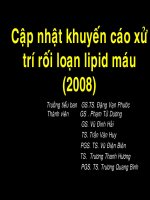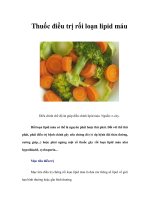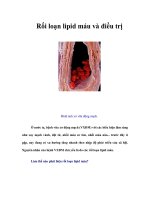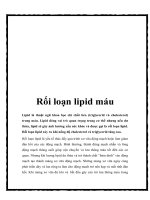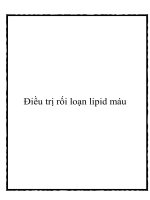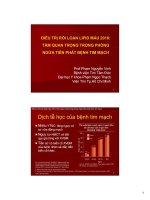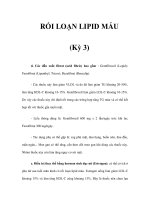Kiểm soát rối loạn lipid máu thế nào để dự phòng đột quỵ
Bạn đang xem bản rút gọn của tài liệu. Xem và tải ngay bản đầy đủ của tài liệu tại đây (1.81 MB, 44 trang )
CHOLESTEROL LOWERING AFTER STROKE
What ? When ? How Much & How Long ?
Nguyen Huy Thang, MD
Department of Cerebrovascular Disease
CASE
• BN nữ 67T, nhập viện vì hôn mê
• NIHSS 34, nhập viện lúc 12g trưa
• Thời điểm còn bình thường gần nhất 1g
sáng
CT - CTA
IV rtPA sau 13 giờ tính từ thời điểm BN còn bình thường
NIHSS 8 lúc xuất viện, mRS 3 sau 3 tháng
CASE
• Bệnh sử
–Không có tiền căn đột quỵ, bệnh mạch vành
–Cao huyết áp không điều trị
• Xét nghiệm:
Lipids: TC: 224 mg/dL; LDL-C: 120 mg/dL
TG: 125 mg/dL; HDL-C: 55 mg/dL
Glycemia: 110 mg%, Hba1c 6%
CHOLESTEROL LOWERING AFTER STROKE
What ? When ? How Much & How Long ?
WHAT TO START ?
Non-Statin Cholesterol Lowering
Stroke Risk
Intervention
No of Trials
Risk Ratio
Diet
10
0.99 (0.85-1.15)
Fibrates
11
1.04 (0.92-1.19)
Resins
4
1.03 (0.54-2.00)
N3 Fatty Acids
8
0.91 (0.56-1.48)
Briel et al. Am J Med 2004;117:596
Non-stroke
Stroke
4S
TNT1
LIPID
Coronary
Disease
CARE
MIRACL
GREACE
PROSPER2
WOSCOPS
Non
Coronary
Disease
ALLHAT
JUPITER
HPS2
SPPARCL
ASCOT
CARDS
1Some
2Mixed
patients with prior stroke
primary and secondary CVD patient populations
Heart Protection Study
HPS Collaborative Group Lancet 2002;360:7
• Tuổi 40 - 80 (n= 20,536)
• Nguy cơ bệnh mạch vành cao:
– Tiền sử nhồi máu cơ tim hoặc bệnh mạch vành
– Tắc nghẽn các mạch máu khác
• Đột quỵ (n=3,280)
• Đột quỵ không kèm mạch vành (n=1,820)
– Tiền sử tiểu đường, tăng huyết áp
• Triglyceride > 135 mg/dl
• Điều trị: 2x2 (factorial design)
– Simvastatin 40 mg vs Matching placebo
– Antioxidant vitamins vs Matching placebo
Heart Protection Study
Patients With vs. Without Prior Stroke
24%
HPS Investigators Lancet 2004;363:757
Patient with Event (5)
HPS: No Reduction in Risk of Recurrent Stroke
in Patients With Prior Cerebrovascular Disease
n=406
n=488
Major Vascular Events
*29% RR, P=.001
Heart Protection Study Collaborative Group. Lancet. 2004;363:757–767.
n=169
n=170
Stroke
SPARCL
Study Design
Double-Blind Period
Patient Population
Stroke or TIA within 1-6 months
4,731
No history of CHD
Patients
Atorvastatin 80 mg/day
Mean on Rx LDL-C 73 mg/dL
LDL-C levels ≥100 mg/dL and
≤190 mg/dL
Baseline LDL-C
133 mg/dL
Placebo
Mean on Rx LDL-C 129 mg/dL
540 Primary Endpoints
Primary End Point (n=576)
Time to the First Occurrence of a Fatal or Non-fatal Stroke
Pre-specified adjustment for geographical region, entry event, time since entry event, gender, and baseline age
The SPARCL Investigators. NEJM 2006;355 549
SPARCL Primary Endpoint
Fatal or Non-Fatal Stroke (%)
Time to Fatal or Non-Fatal Stroke
16%
Placebo
Atorvastatin
12%
16%
8%
4%
Adjusted HR (95% CI) = 0.84 (0.71, 0.99),
p = 0.03
0%
0
1
2
3
4
5
6
Years Since Randomization
The SPARCL Investigators. NEJM 2006;355:549
Pre-specified adjustmentfor geographical
region, entry event, time since entry event,
sex, and age.
“ Statin therapy with intensive lipid-lowering effects is
recommended to reduce risk of stroke and
cardiovascular events among patients with ischemic
stroke or TIA ”
(Class I; Level of Evidence B)
WHEN TO START?
WHEN TO START ?
• Heart Protection Study: Thời gian bắt đầu sử
dụng sau Đột Qụy # 4.3 năm
Không ghi
nhận lợi ích của Simvastatin
• SPARCL: 1 – 6 tháng
Giảm 16% nguy cơ ĐQ
• Guidelines: Sự tuân thủ điều trị sẽ tốt hơn nếu
bắt đầu sử dụng trong thời gian nằm viện
HOW MUCH ?
Statins and Hemorrhagic Stroke
Meta-analysis
Amarenco P, Labreuche J. Lancet Neurol. 2009; 8:453-63
SPARCL Ischemic and Hemorrhagic Stroke
Post hoc analysis
Fatal and Non-fatal Stroke
Ischemic or Hemorrhagic Stroke (%)
16
Placebo: Ischemic
Atorvastatin: Ischemic
Placebo: Hemorrhagic
Atorvastatin: Hemorrhagic
21%
12
Ischemic: HR (95% CI) = 0.79 (0.66, 0.95)
8
4
Hemorrhagic: HR (95% CI) = 1.68 (1.09, 2.59)
0
0
1
2
3
Years Since Randomization
Goldstein et al. Neurology 2008;70: 2364-2370
4
5
6
Unadjusted HR
SPARCL
Entry Events
Atorvastatin
(N=2365)
Stroke
Ischemic stroke
Hemorrhagic stroke
Not determined
TIA
Placebo
(N=2366)
N
%
N
1655
1595
45
15
70.0
67.4
1.9
0.6
1613
1559
48
6
708
29.9
752
%
68.2
65.9
2.0
0.3
31.8
The SPARCL Investigators. NEJM 2006;355: 549-559
SPARCL Exploratory Analysis
Hemorrhagic Stroke
• Nguy cơ xuất huyết có tăng lên đối với các BN xuất
huyết não?
• Nguy cơ xuất huyết não có liên quan với mức giảm LDLC?
• Các yếu tố khác có liên quan với Nguy cơ xuất huyết
não? Huyết áp, tuổi
Goldstein et al. Neurology 2008;70:2364
SPARCL Multivariable Cox Regression Model
Baseline Characteristics & Time Varying LDL-C
Risk of hemorrhage
OR (95% CI)
p
Hemorrhage as entry event
8.38 (3.78, 18.56)
<0.001
Male sex
2.21 (1.20, 4.09)
0.01
Age (10 yr increments)
1.40 (1.08, 1.81)
0.01
1.26 (0.60, 2.64)
0.97 (0.44, 2.17)
1.37 (0.63, 2.98)
0.77
0.54
0.94
0.43
LDL-cholesterol (quartiles)
52-65 mg/dL
66-92 mg/dL
>93 mg/dL
For atorvastatin-treated patients
Goldstein et al. Neurology 2008;70:2364
SPARCL Multivariable Cox Regression Model
Baseline Characteristics & Time-Varying BP
Risk of hemorrhage
Blood Pressure
Pre-hypertension
Stage 1 hypertension
Stage 2 hypertension
OR (95% CI)
3.18 (0.76, 13.34)
3.49 (0.83, 14.61)
6.19 (1.47, 26.11)
p
0.01
0.11
0.09
0.01
Pre-HTN: SBP 120-139 or DBP 80-89
Stage 1: SBP 140-159 or DBP 90-99
Stage 2: SBP>160 or DBP>100
Goldstein et al. Neurology 2008;70 2364
Time Varying LDL-C and Stroke Risk
HR (95% CI)
p-value
All Stroke
≥0% Increase
1.00
<50% Decrease
≥50% Decrease
0.89 (0.73, 1.08)
0.69 (0.55, 0.87)
0.2253
0.0016
Ischemic Stroke
≥0% Increase
1.00
<50% Decrease
≥50% Decrease
0.90 (0.73, 1.12)
0.67 (0.52, 0.86)
0.3394
0.0018
Hemorrhagic Stroke
≥0% Increase
1.00
<50% Decrease
≥50% Decrease
0.84 (0.50, 1.40)
1.04 (0.61, 1.78)
0.4716
0.8864
Note: Percent change effects from Cox proportional hazards
models with adjustment for gender and baseline age with
reference group = no change or increase
0.4
0.7
1.0
1.3
Hazard Ratio (95% CI)
Amarenco P, Goldstein LB, Szarek M, et al. Stroke. 2007;38:3198-3204
1.6 1.9 2.2
